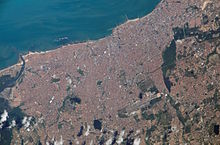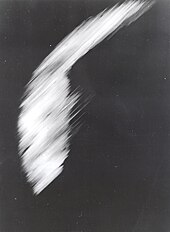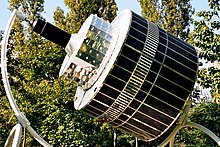Review the Satellite Photo at the Beginning of This Chapter

The first images from infinite were taken on the sub-orbital 5-two rocket flight launched by the U.Southward. on October 24, 1946.

Satellite images (as well Earth ascertainment imagery, spaceborne photography, or just satellite photo) are images of Earth collected past imaging satellites operated past governments and businesses around the globe. Satellite imaging companies sell images by licensing them to governments and businesses such as Apple tree Maps and Google Maps.
History [edit]

The satellite images were fabricated from pixels. The first crude image taken by the satellite Explorer 6 shows a sunlit area of the Central Pacific Ocean and its cloud cover. The photo was taken when the satellite was near 17,000 mi (27,000 km) above the surface of the earth on Baronial xiv, 1959. At the fourth dimension, the satellite was crossing United mexican states.
The kickoff images from infinite were taken on sub-orbital flights. The U.S-launched Five-two flight on October 24, 1946 took one epitome every 1.5 seconds. With an apogee of 65 miles (105 km), these photos were from 5 times higher than the previous record, the 13.7 miles (22 km) by the Explorer Ii airship mission in 1935.[ane] The first satellite (orbital) photographs of Earth were made on August 14, 1959 by the U.S. Explorer 6.[ii] [3] The first satellite photographs of the Moon might have been fabricated on Oct 6, 1959 by the Soviet satellite Luna 3, on a mission to photograph the far side of the Moon. The Blue Marble photo was taken from space in 1972, and has go very popular in the media and among the public. Too in 1972 the The states started the Landsat program, the largest program for acquisition of imagery of Earth from space. In 1977, the outset real time satellite imagery was acquired by the United states'south KH-11 satellite arrangement. The most recent Landsat satellite, Landsat 9, was launched on 27 September 2021.[four]

The get-go television image of Earth from space transmitted by the TIROS-1 weather satellite in 1960.
All satellite images produced by NASA are published by NASA Earth Observatory and are freely available to the public. Several other countries take satellite imaging programs, and a collaborative European attempt launched the ERS and Envisat satellites carrying various sensors. There are likewise private companies that provide commercial satellite imagery. In the early on 21st century satellite imagery became widely bachelor when affordable, easy to use software with access to satellite imagery databases was offered past several companies and organizations.
Uses [edit]

Satellite photography can be used to produce composite images of an unabridged hemisphere

...or to map a pocket-sized area of the Earth, such as this photo of the countryside of Haskell Canton, Kansas, Us.
Satellite images take many applications in meteorology, oceanography, fishing, agriculture, biodiversity conservation, forestry, landscape, geology, cartography, regional planning, education, intelligence and warfare. Less mainstream uses include anomaly hunting, a criticized investigation technique involving the search of satellite images for unexplained phenomena.[5] Images can exist in visible colors and in other spectra. There are too meridian maps, normally fabricated by radar images. Image interpretation and analysis of satellite imagery is conducted using specialized remote sensing software.
Data characteristics [edit]
There are five types of resolution when discussing satellite imagery in remote sensing: spatial, spectral, temporal, radiometric and geometric. Campbell (2002)[6] defines these every bit follows:
- spatial resolution is defined as the pixel size of an paradigm representing the size of the surface area (i.e. mtwo) existence measured on the ground, determined past the sensors' instantaneous field of view (IFOV);
- spectral resolution is defined past the wavelength interval size (discrete segment of the Electromagnetic Spectrum) and number of intervals that the sensor is measuring;
- temporal resolution is divers by the amount of time (e.1000. days) that passes between imagery drove periods for a given surface location
- Radiometric resolution is defined equally the ability of an imaging system to record many levels of brightness (dissimilarity for example) and to the effective bit-depth of the sensor (number of grayscale levels) and is typically expressed as 8-fleck (0–255), 11-bit (0–2047), 12-fleck (0–4095) or sixteen-bit (0–65,535).
- Geometric resolution refers to the satellite sensor'due south ability to effectively image a portion of the Earth's surface in a single pixel and is typically expressed in terms of Basis sample distance, or GSD. GSD is a term containing the overall optical and systemic noise sources and is useful for comparing how well ane sensor can "see" an object on the basis within a single pixel. For instance, the GSD of Landsat is ≈30m, which means the smallest unit that maps to a single pixel within an image is ≈30m x 30m. The latest commercial satellite (GeoEye one) has a GSD of 0.41 grand. This compares to a 0.3 m resolution obtained by some early on military film based Reconnaissance satellite such as Corona.[ commendation needed ]
The resolution of satellite images varies depending on the instrument used and the distance of the satellite's orbit. For example, the Landsat annal offers repeated imagery at 30 meter resolution for the planet, just most of it has not been processed from the raw information. Landsat 7 has an average return menses of sixteen days. For many smaller areas, images with resolution as loftier equally 41 cm can be available.[7]
Satellite imagery is sometimes supplemented with aeriform photography, which has higher resolution, but is more expensive per square meter. Satellite imagery can be combined with vector or raster data in a GIS provided that the imagery has been spatially rectified so that it volition properly align with other data sets.
Imaging satellites [edit]
Public Domain [edit]
Satellite imaging of the Earth surface is of sufficient public utility that many countries maintain satellite imaging programs. The The states has led the fashion in making these data freely available for scientific apply. Some of the more pop programs are listed below, recently followed past the European Union's Sentinel constellation.
CORONA [edit]
The CORONA programme was a serial of American strategic reconnaissance satellites produced and operated by the Fundamental Intelligence Agency (CIA) Advisers of Science & Technology with substantial assistance from the U.S. Air Force. blazon of imagery is wet motion picture Panoramic and information technology used two cameras (AFT&FWD) For capturing stereo-graphic imagery.
Landsat [edit]
Landsat is the oldest continuous Earth-observing satellite imaging program. Optical Landsat imagery has been collected at 30 m resolution since the early 1980s. Beginning with Landsat 5, thermal infrared imagery was besides collected (at coarser spatial resolution than the optical information). The Landsat 7, Landsat 8, and Landsat 9 satellites are currently in orbit.
MODIS [edit]
MODIS has nerveless near-daily satellite imagery of the world in 36 spectral bands since 2000. MODIS is on board the NASA Terra and Aqua satellites.
Sentry [edit]
The ESA is currently developing the Lookout man constellation of satellites. Currently, seven missions are planned, each for a different application. Picket-ane (SAR imaging), Sentinel-2 (decameter optical imaging for state surfaces), and Sentinel-iii (hectometer optical and thermal imaging for country and water) have already been launched.
ASTER [edit]
The ASTER is an imaging musical instrument onboard Terra, the flagship satellite of NASA's Earth Observing System (EOS) launched in December 1999. ASTER is a cooperative effort betwixt NASA, Japan's Ministry of Economy, Trade and Industry (METI), and Japan Space Systems (J-spacesystems). ASTER data is used to create detailed maps of country surface temperature, reflectance, and elevation. The coordinated system of EOS satellites, including Terra, is a major component of NASA's Science Mission Directorate and the Earth Science Division. The goal of NASA Earth Science is to develop a scientific understanding of the Earth as an integrated system, its response to change, and to ameliorate predict variability and trends in climate, weather condition, and natural hazards.[viii]
- Land surface climatology—investigation of state surface parameters, surface temperature, etc., to empathise country-surface interaction and energy and moisture fluxes
- Vegetation and ecosystem dynamics—investigations of vegetation and soil distribution and their changes to estimate biological productivity, understand state-atmosphere interactions, and discover ecosystem change
- Volcano monitoring—monitoring of eruptions and precursor events, such as gas emissions, eruption plumes, development of lava lakes, eruptive history and eruptive potential
- Chance monitoring—observation of the extent and effects of wildfires, flooding, coastal erosion, earthquake damage, and tsunami impairment
- Hydrology—agreement global free energy and hydrologic processes and their relationship to global change; included is evapotranspiration from plants
- Geology and soils—the detailed limerick and geomorphologic mapping of surface soils and bedrocks to report land surface processes and earth's history
- Land surface and land embrace modify—monitoring desertification, deforestation, and urbanization; providing data for conservation managers to monitor protected areas, national parks, and wilderness areas
Meteosat [edit]

Model of a first generation Meteosat geostationary satellite.
The Meteosat-two geostationary atmospheric condition satellite began operationally to supply imagery information on 16 Baronial 1981. Eumetsat has operated the Meteosats since 1987.
- The Meteosat visible and infrared imager (MVIRI), three-channel imager: visible, infrared and water vapour; It operates on the first generation Meteosat, Meteosat-7 beingness nevertheless active.
- The 12-channel Spinning Enhanced Visible and Infrared Imager (SEVIRI) includes similar channels to those used past MVIRI, providing continuity in climate information over three decades; Meteosat 2d Generation (MSG).
- The Flexible Combined Imager (FCI) on Meteosat 3rd Generation (MTG) volition besides include similar channels, meaning that all three generations will take provided over 60 years of climate data.
Private domain [edit]
Several satellites are built and maintained by private companies, as follows.
GeoEye [edit]
GeoEye's GeoEye-ane satellite was launched on September 6, 2008.[9] The GeoEye-1 satellite has loftier resolution imaging system and is able to collect images with a basis resolution of 0.41 meters (sixteen inches) in panchromatic or black and white mode. Information technology collects multispectral or color imagery at 1.65-meter resolution or about 64 inches.

WorldView-2 prototype of Bristol metropolis.
Maxar [edit]
Maxar'south WorldView-2 satellite provides high resolution commercial satellite imagery with 0.46 yard spatial resolution (panchromatic only).[10] The 0.46 meters resolution of WorldView-two'southward panchromatic images allows the satellite to distinguish between objects on the basis that are at least 46 cm apart. Similarly Maxar's QuickBird satellite provides 0.6 meter resolution (at nadir) panchromatic images.
Maxar's WorldView-3 satellite provides high resolution commercial satellite imagery with 0.31 g spatial resolution. WVIII also carries a short wave infrared sensor and an atmospheric sensor[11]
Airbus Intelligence [edit]

Pleiades image of the central park-New York metropolis.
Pléiades constellation is composed of 2 very-high-resolution (l centimeters pan & 2.1 meter spectral) optical Earth-imaging satellites. Pléiades-60 minutes 1A and Pléiades-Hr 1B provide the coverage of Earth'southward surface with a echo cycle of 26 days. Designed as a dual civil/military arrangement, Pléiades will meet the space imagery requirements of European defence as well every bit civil and commercial needs. Pléiades Neo [12] is the advanced optical constellation, with 4 identical 30-cm resolution satellites with fast reactivity.
Spot Prototype [edit]

The 3 SPOT satellites in orbit (Spot 5, 6, 7) provide very loftier resolution images – 1.5 k for Panchromatic channel, 6m for Multi-spectral (R,G,B,NIR). Spot Image also distributes multiresolution data from other optical satellites, in particular from Formosat-2 (Taiwan) and Kompsat-ii (South Korea) and from radar satellites (TerraSar-X, ERS, Envisat, Radarsat). Spot Image is also the exclusive distributor of data from the high resolution Pleiades satellites with a resolution of 0.50 meter or about xx inches. The launches occurred in 2011 and 2012, respectively. The company also offers infrastructures for receiving and processing, also every bit added value options.
Planet's RapidEye [edit]
In 2015, Planet acquired BlackBridge, and its constellation of five RapidEye satellites, launched in August 2008.[13] The RapidEye constellation contains identical multispectral sensors which are equally calibrated. Therefore, an paradigm from 1 satellite volition be equivalent to an image from any of the other four, allowing for a big amount of imagery to be nerveless (4 1000000 km2 per mean solar day), and daily revisit to an area. Each travel on the same orbital aeroplane at 630 km, and deliver images in 5 meter pixel size. RapidEye satellite imagery is especially suited for agricultural, environmental, cartographic and disaster management applications. The company non only offers their imagery, just consults their customers to create services and solutions based on assay of this imagery. The RapidEye constellation was retired by Planet in April 2020.
ImageSat International [edit]
Earth Resource Observation Satellites, better known every bit "EROS" satellites, are lightweight, low earth orbiting, high-resolution satellites designed for fast maneuvering between imaging targets. In the commercial high-resolution satellite market, EROS is the smallest very high resolution satellite; it is very active and thus enables very high performances. The satellites are deployed in a round sunday-synchronous near polar orbit at an distance of 510 km (± 40 km). EROS satellites imagery applications are primarily for intelligence, homeland security and national evolution purposes just too employed in a wide range of civilian applications, including: mapping, edge control, infrastructure planning, agronomical monitoring, environmental monitoring, disaster response, grooming and simulations, etc.
EROS A – a high resolution satellite with 1.9–1.2m resolution panchromatic was launched on December five, 2000.
EROS B – the second generation of Very Loftier Resolution satellites with 70 cm resolution panchromatic, was launched on Apr 25, 2006.
China Siwei [edit]
GaoJing-ane / SuperView-1 (01, 02, 03, 04) is a commercial constellation of Chinese remote sensing satellites controlled by China Siwei Surveying and Mapping Technology Co. Ltd. The four satellites operate from an altitude of 530 km and are phased 90° from each other on the same orbit, providing 0.5m panchromatic resolution and 2m multispectral resolution on a swath of 12 km.[xiv] [15]
Disadvantages [edit]

Blended image of Earth at night, equally but half of Earth is at nighttime at any given moment.
Considering the total area of the land on Globe is so large and because resolution is relatively high, satellite databases are huge and image processing (creating useful images from the raw data) is time-consuming.[ citation needed ] Preprocessing, such as image destriping, is often required. Depending on the sensor used, weather conditions can bear upon image quality: for case, information technology is difficult to obtain images for areas of frequent cloud cover such as mountaintops. For such reasons, publicly available satellite image datasets are typically processed for visual or scientific commercial use by third parties.
Commercial satellite companies practice not identify their imagery into the public domain and do non sell their imagery; instead, one must learn a license to utilise their imagery. Thus, the ability to legally make derivative works from commercial satellite imagery is macerated.
Privacy concerns have been brought up by some who wish not to take their holding shown from above. Google Maps responds to such concerns in their FAQ with the following argument: "Nosotros empathise your privacy concerns... The images that Google Maps displays are no different from what can be seen past anyone who flies over or drives by a specific geographic location."[sixteen]
See besides [edit]
- Aerial photography
- World observation satellite
- Moderate-resolution imaging spectroradiometer
- Reconnaissance satellite
- Remote sensing
- Shuttle Radar Topography Mission
- Stratellite
- Timeline of first images of Earth from space
- Virtual world
- NASA World Wind
- Weather satellite
References [edit]
- ^ The Offset Photo From Space, Tony Reichhardt, Air & Space Magazine, November 01, 2006
- ^ "fifty years of Earth Observation". 2007: A Space Jubilee. European Space Bureau. October 3, 2007. Retrieved 2008-03-20 .
- ^ "First Film from Explorer Six Satellite". NASA. Archived from the original on 2009-xi-30.
- ^ "When was the Landsat 9 satellite launched?". www.usgs.gov . Retrieved 2021-ten-25 .
- ^ Radford, Benjamin (2019). "Anomaly Hunting with Satellite Images". Skeptical Inquirer. Vol. 43, no. 4. Center for Inquiry. pp. 32–33.
- ^ Campbell, J. B. 2002. Introduction to Remote Sensing. New York London: The Guilford Press[ pages needed ]
- ^ grayaudio on Mar xv, 2010 (23 February 2009). "World'southward Highest-Resolution Satellite Imagery". HotHardware. Retrieved 2013-06-09 .
- ^ "ASTER Project". Archived from the original on 2005-03-22. Retrieved 2015-04-06 .
- ^ Shall, Andrea (September 6, 2008). "GeoEye launches high-resolution satellite". Reuters . Retrieved 2008-xi-07 .
- ^ "Ball Aerospace & Technologies Corp". Retrieved 2008-11-07 .
- ^ "High Resolution Aerial Satellite Images & Photos". Retrieved 2014-x-24 .
- ^ Pléiades Neo
- ^ "RapidEye Press Release" (PDF) . Retrieved 2013-06-09 .
- ^ "GaoJing / SuperView - Satellite Missions - eoPortal Directory". directory.eoportal.org . Retrieved 2019-11-14 .
- ^ "GaoJing-1 01, 02, 03, 04 (SuperView ane)". space.skyrocket.de . Retrieved 2019-xi-14 .
- ^ Catherine Betts told the Associated Press (2007) http://news.nationalgeographic.com/news/2007/03/070312-google-censor_2.html
External links [edit]
- ESA Envisat Meris – 300m – the nearly detailed image of the entire Globe to date, made by the European Space Agency's Envisat Meris.
- Blue Marble: Side by side Generation – a detailed truthful-colour image of the unabridged Earth.
- Earth Wind – an open up source 3D Earth-viewing software adult by NASA that accesses NASA JPL database
chaffeythounater44.blogspot.com
Source: https://en.wikipedia.org/wiki/Satellite_imagery